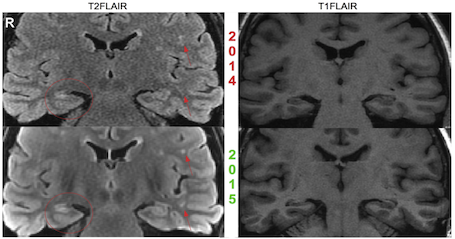Neuroradiological findings in patients with “non-lesional” focal epilepsy revealed by research protocol

Abstract
Aim: To evaluate whether a dedicated epilepsy research protocol with expert image re- evaluation can increase identification of patients with lesions and to attempt to ascertain the potential reasons why lesions were not identified previously on earlier clinical magnetic resonance imaging (MRI). Materials and Methods: Forty-three patients (26 female) with focal refractory epilepsy who had failed at least two trials of anti-epileptic drug treatments were studied. Patients were recruited prospectively into the study if previous clinical MRI was deemed to be “non-lesional” by the clinicians involved in the initial assessment. Three-dimensional (3D) T1-weighted (T1W), T2-weighted (T2W), T2 fluid-attenuated inversion recovery (T2-FLAIR) sequences, and two-dimensional (2D) coronal T1-/T2W FLAIR were assessed by a neuroradiologist, including the previous clinical MRI of individual patients. Results: Twenty-nine or 43 (67%) patients remained MRI-negative after scanning with the epilepsy-dedicated protocol and image reappraisal by expert consultant neuroradiologists; however, 14/43 (33%) patients were found to have potentially epileptogenic brain lesions. The lesion that most frequently escaped the attention of clinicians was hippocampal sclerosis (nine cases, of which two had an additional focal cortical dysplasia, FCD), followed by single FCDs (two cases), and others including gliosis, encephalocoele, and amygdala enlargement (one case each). Eleven of the 14 (79%) previously “non-lesional” patients had electroencephalogram (EEG) imaging-concordant localisation features, rendering them potential candidates for resective surgery. Conclusions: The primary factors explaining the newly identified lesions were the choice of MRI sequences, imaging parameters, data quality, lesion not reported (human factor), and loss of information through incomplete documentation. It is important for all clinicians to proceed meticulously in the detailed assessment of epilepsy-dedicated in-vivo MRI and discuss difficult patient cases in multidisciplinary team meetings.